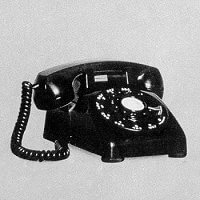Note: This is the second installment analyzing the new State Board of Education/Kansas State Department of Education initiative called “Kansans Can.” Click here for the first article.
Until the breakup of the Bell system in the 1980’s, AT&T had a monopoly on phone service; people had no choice. In order to reassure customers that they were in good hands, one of their ad campaigns during the 1970s used the slogan, “The system is the solution.”
Since they had no competition, their main goal was to convince us that whatever they provided fit whatever needs we might have. What did a one-size-fits-all phone service provide back in the day? Innovation? Quality service at a fair price?
This is what a phone looked like in the 1920s.

This is what a phone looked like 50 years later.
 A half-century of monopoly-based innovation gave us…the curly cord.
A half-century of monopoly-based innovation gave us…the curly cord.
How about price? Many of you reading this may remember when long distance phone calls (even that term has become archaic) had to be scheduled in order to maximize bang for the buck. I recall huddling around the curly cord with the rest of the family so we wouldn’t waste a single second, since long-distance rates were in the neighborhood of three dollars a minute. To put that in perspective, the minimum wage was less than three dollars an hour. Even the cheapest rates (Sunday evening after 10:00 pm, as I recall) were about $18 an hour.
This is not meant to be a phone system history lesson. It is meant to show a striking parallel between a communication system of days long gone and the current education system that has a similar monopoly on educating Kansas students.
The State Board of Education has recently adopted their version of “The system is the solution.” It is called Kansans Can. In the aforementioned blog I presented the failings of the initiative, describing it as little more than rearranging deck chairs. Regardless of the good intentioned rhetoric of Kansans Can, it still operates in a system rooted in the 19th century – a one-size-fits-all system with no desire or incentive to change. Unfortunately, the system of Kansas schools isn’t much a solution for the thousands of Kansas school children who lag multiple grades behind their peers.
The purpose here is to identify a pathway forward, a true student-centered approach to improving opportunities and educational outcomes for all Kansas students.
School Choice
The cornerstone of such an approach is, in a word: choice. While the rest of the country moves forward with choice options as part of education reform – expansion of public charter schools, educational spending accounts, targeted private school vouchers for students with special needs, and expanded choice options for students in failing schools as examples – Kansas continues to mire in the past with a blind eye to the future. The depths of this denial was expressed by Education Commissioner Dr. Randy Watson at a recent Kansas Association of American Educators (KANAAE) roundtable. While Dr. Watson was describing the virtues of Kansans Can to the group, I asked him how school choice fit into that initiative.
His response: “School choice wouldn’t be good for Kansas…we’re too rural.” Really, that’s what was said by the one person in charge of providing quality education for all students in the state. Giving people a choice is not good. Let’s look at that statement, that attitude from several perspectives.
- First, that choice wouldn’t be good for Kansas. Choice is not good? A monopoly is better? It makes me wonder if Dr. Watson still uses a rotary phone. If choice is not good, why does the research show that students in charter schools outperform their traditional public school counterparts? Why do many charter schools around the country have to hold lotteries for students to be accepted? In Massachusetts, 34,000 students are on charter waiting lists. If that’s not enough, consider all the philanthropic donations that are going to help schools of choice. The Walton Family Foundation is providing $250 million toward charter schools to allow them to get financing for facilities. The Eli and Edythe Broad foundation is spearheading a drive to raise nearly a half-billion dollars for public charter expansion in Los Angeles.
- Second, that Kansas is “too rural.” According to the 2015-16 KSDE headcount of Kansas students, over 54% of the roughly 491,000 students in Kansas schools are in the 20 largest of the 286 districts in Kansas. Even more revealing is the fact that over 310,000 students are in the urban areas of Wichita, Kansas City, Topeka, Lawrence, Salina and Manhattan.
- Third, that rural areas couldn’t take advantage of choice. Here’s where their 19th century is showing. That attitude sees educating kids as a function of brick and mortar, of a central gathering of kids of like age, of seat time, of a one-grade-at-a-time approach. In other words, they wonder who could possibly come into a small town like __________ (fill in the blank) and build another school. Obviously, this is an eyeglass-in-reverse perspective – that there’s only one educational paradigm.
- Fourth, that somehow if everyone doesn’t have the same access to more educational opportunities, no one should have them. How do you tell a student stuck in a Wichita, Kansas City, or Topeka school that is failing them that they aren’t allowed other choices because those same choices aren’t available in ____________ (again, fill in the blank). KSDE identified those failing schools as Priority and Focus schools. Almost all of them, coincidentally, are in the urban areas of Wichita, Kansas City and Topeka. School choice is thriving in states like California, Florida, New York, Indiana and Louisiana, all with significant rural populations. New choice proposals are moving forward in Mississippi and Georgia, two states that also have large rural areas.
Closing Achievement Gaps
The dirty little secret that public education tries to sweep under the rug is the appalling achievement gaps that persist between the economically haves and have-nots. How can there be a credible approach to improving educational outcomes if achievement gaps involving nearly half the students are not addressed? There is no mention of dealing with that issue in Kansans Can.
Gaps in reading and math achievement become apparent in the early grades but there is nothing in Kansans Can that focuses on the foundational skills necessary for students to realize success in the later grades and on through college. There must be a concerted effort to reach those underperforming students to get them to reading at grade level in the early grades. Studies like this Johns Hopkins report provide evidence of the importance of early reading ability on future success. Schools need to target the funding that was intended for at-risk students. The practice of social promotion has to be abandoned; kids should not be moved forward until they are academically ready.
Political analyst Juan Williams, in this Wall Street Journal article calls the failure to address achievement gaps “the scandal of K-12 education.” He says that “every state (has) to take full responsibility for all students who aren’t making the grade – and get those students help now.” And in what could be a message directed specifically to Kansas, this “means increasing options for parents, from magnet to charter schools. Embracing competition among schools is essential…”
Furthermore, this month marks the fiftieth anniversary of the famous Coleman Report, which identified inequities in academic achievement, being presented to Congress. Even a half-century ago it recognized the importance of families, not just schools, as being key drivers of student achievement. If parents are the drivers, school choice is the vehicle.
While the rest of the country is looking to school choice as a key component to education reform, Kansas continues to take an insular approach. The SBOE and KSDE are clinging to an ancient system as the solution, instead of allowing students and families to choose how they want to be educated.
Over the past generation, we’ve witnessed how the breakup of the Bell system led to unthinkable innovation that has transformed how we communicate. (Just try taking a selfie with a rotary phone!). In fact many of you may actually be reading this on your phone. A generation ago that concept was unimaginable, but that’s what happens when the shackles of monopoly are removed and the spirit of innovation is released.
If we continue down the same road with initiatives like Kansans Can, forsaking choice and avoiding the harsh realities of achievement gaps, we will have nothing more to show for it than a curly cord.





